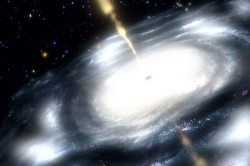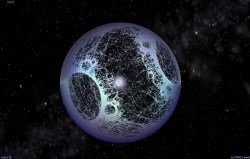Is there any possible way to take a black hole and terraform it to be a place we could actually live?
In the challenge of terraforming the Sun, we all learned that outside of buying a Dyson Spaceshell 2000 made out of a solar system’s worth of planetbutter, it’s a terrible idea.
Making a star into a habitable world, means first destroying the stellar furnace. Which isn’t good for anyone, “Hey, free energy! vs. Let’s wreck this thing and build houses!”
Doubling down on this idea, a group of brilliant Guidensians wanted to crank the absurdity knob all the way up. You wanted to know if it would be possible to terraform a black hole.
In order to terraform something, we convert it from being Britney Spears’ level of toxic into something that humans can comfortably live on. We want reasonable temperatures, breathable atmosphere, low levels of radiation, and Earthish gravity.
With temperatures inversely proportional to their mass, a solar mass black hole is about 60 billionths of a Kelvin. This is just a smidge over absolute zero. Otherwise known as “pretty damn” cold. Actively feeding black holes can be surrounded by an accretion disk of material that’s more than 10 million degrees Kelvin, which would also kill you. Make a note, fix the temperature.
There’s no atmosphere, and it’s either the empty vacuum of space, or the superheated plasma surrounding an actively feeding black hole. Can you breathe plasma? If the answer is yes, this could work for you. If not, we’ll need to fix that.
You’d be hard pressed to find a more lethal radiation source in the entire Universe.
Black holes can spin at close to the speed of light, generating massive magnetic fields. These magnetic fields whip high energy particles around them, creating lethal doses of radiation. There are high energy particle jets pouring out of some supermassive black holes, moving at nearly the speed of light. You don’t want any part of that. We’ll add that to the list.
Black holes are known for being an excellent source of vitamin gravity. Out in orbit, it’s not so bad. Replace our Sun with a black hole of the same mass, and you wouldn’t be able to tell the difference.
So, problem solved? Not quite. If you tried to walk on the surface, you’d get shredded into a one-atom juicy stream of extruded tubemanity before you got anywhere near the time traveling alien library at the caramel center.
Reduce the gravity. Got it.

As we learned in a previous episode on how to kill black holes, there’s nothing you can do to affect them. You couldn’t smash comets into it to give it an atmosphere, it would just turn them into more black hole. You couldn’t fire a laser to extract material and reduce the mass, it would just turn your puny laser into more black hole.
Antimatter, explosives, stars, rocks, paper, scissors…black hole beats them all.
Repeat after me. “Om, nom, nom”.
All we can do is wait for it to evaporate over incomprehensible lengths of time. There are a few snags with this strategy, such as it will remain as a black hole until the last two particles evaporate away. There’s no point where it would magically become a regular planetoid.
That’s a full list of renovations for the cast and crew of “Pimp my Black Hole”.
Let’s look at our options. You can move it, just like we can move the Earth. Throw stuff really close to a black hole, and you get it moving with gravity. You could make it spin faster by dropping stuff into it, right up until it’s rotating at the edge of the speed of light, and you can make it more massive.
With that as our set of tools, there’s no way we’re ever going to live on a black hole.
It could be possible to surround a black hole with a Dyson Sphere, like a star.

It turns out there’s a way to have a pet black hole pay dividends aside from eating all your table scraps, shameful magazines and radioactive waste. By dropping matter into a black hole that’s spinning at close to the speed of light, you can actually extract energy from it.
Imagine you had an asteroid that was formed by two large rocks. As they get closer and closer to the black hole, tidal forces tear them apart. One chunk falls into the black hole, the smaller remaining rock has less collective mass, which allows it to escape. This remaining rock steals rotational energy from the black hole, which then slows down the rotation just a little bit.
This is the Penrose Process, named after the physicist who developed the idea. Astronomers calculated you can extract 20% of pure energy from matter that you drop in.
There’s isn’t much out there that would give you better return on your investment.
Also, it’s got to have a similar satisfying feeling as dropping pebbles off a bridge and watching them disappear from existence.
Terraforming a black hole is a terrible idea that will totally get us all killed. Don’t do it.
If you have to get close to that freakish hellscape I do recommend surrounding your pet with a Dyson Sphere and then feeding it matter and enjoying the energy you get in return.
A futuristic energy hungry civilization bent on evil couldn’t hope for a better place to live.
Have you got any more questions about black holes? Give us your suggestions in the comments below.


Can I have some of that stuff you are smoking, Fraser? 😉
This is really a ridiculous concept. Not to be disrespectful but the recent radio telescope data has give a much clearer picture of a “black hole”. First of all there is nothing “black” about them. They emit tremendous quantities of electromagnetic radiation and have recently been observed to be emitting jets of plasma. These bodies should be more appropriately be referred to as galactic centers. The overwhelming evidence is they are rapidly rotating, super dense plasmoids. The charge separation within the rotating plasmoid generates massive magnetic fields which have been documented. Gravity has little to do with these bodies, This model does not require infinite gravity, infinite mass, dark energy or dark matter. It also provides for the necessary energy for galaxy and star formation. It also makes a lot of sense. These are massive electromagnetic events. It’s time to see galaxy and star formation, as well as “black hole” structure as the electromagnetic events which they clearly are.
Attempts to terraform lightening would be equally as successful as terraforming a “black hole”.
You again! I’ve asked you before: If not gravity, then what/where is the driving force of all that energy?
If it’s anything like my personality, Magnets !
Not this Electric Universe gibberish again.
There is actualy something odd if you move two blackholes close to each other ….
The event horizon lowers if you hold two blackholes close to each other, on the side facing the other blackhole (and increases on the opposite side)
A well known thing would be L1, the first Lagrange which lies between two masses.
I assume that if you manage to get L1 of B2 (blackhole 2) at just right spot within [the event horizon of] B1, than you’ld have lowered the event horizon far enough to siphon off material from B1 (and visa versa)
So, in theory, with dedication, and lots of time … you could use other blackholes to siphon off B1 far enough until … ***
that’s the way little Black Holes are made: closer….. closer…. more…. and now – switch off the light…. and get out!
that is the way “little Black Holes” are made: closer….. closer….. more… now, switch off the light…. and GET OUT!
Well, if you could build a rigid shell around your black hole with a radius of 8.25 million km*, it would have Earth-like surface gravity, so there’s a start (nevermind the impossible material properties required and the issue of keeping the black hole centered…).
* assuming a 5-solar-mass black hole